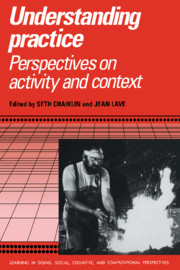Book contents
- Frontmatter
- Contents
- Series foreword
- List of contributors
- Part I Introduction
- Part II Learning craftwork
- Part III Learning as social production
- 8 Examinations reexamined: Certification of students or certification of knowledge?
- 9 Beneath the skin and between the ears: A case study in the politics of representation
- 10 The acquisition of a child by a learning disability
- 11 Context and scaffolding in developmental studies of mother–child problem-solving dyads
- 12 Solving everyday problems in the formal setting: An empirical study of the school as context for thought
- 13 Teacher's directives: The social construction of “literal meanings” and “real worlds” in classroom discourse
- Part IV Conclusion
- Author index
- Subject index
- Learning in Doing: Social, Cognitive, and Computational Perspectives
10 - The acquisition of a child by a learning disability
Published online by Cambridge University Press: 06 January 2010
- Frontmatter
- Contents
- Series foreword
- List of contributors
- Part I Introduction
- Part II Learning craftwork
- Part III Learning as social production
- 8 Examinations reexamined: Certification of students or certification of knowledge?
- 9 Beneath the skin and between the ears: A case study in the politics of representation
- 10 The acquisition of a child by a learning disability
- 11 Context and scaffolding in developmental studies of mother–child problem-solving dyads
- 12 Solving everyday problems in the formal setting: An empirical study of the school as context for thought
- 13 Teacher's directives: The social construction of “literal meanings” and “real worlds” in classroom discourse
- Part IV Conclusion
- Author index
- Subject index
- Learning in Doing: Social, Cognitive, and Computational Perspectives
Summary
Conceived as a deficiency in capacity, feeblemindedness isolates the subject by virtue of that deficiency. In seeking a definite cause of feeblemindedness one is denying that it can have any meaning – that is, a history – or that it may correspond to a situation.
(Maud Mannoni, 1972, p. 44)The interiority of pains, afterimages and spots before the eyes cannot impugn the overt, public character of cognitive skills, or the external aims of practical moral decisions. It is only when mental activity regains its place within everyday life, therefore that its outer directness becomes finally clear.
(Stephen Toulmin, 1985, p. 17)The emergence of institutionalized education is accompanied by a crisis in diffuse education, which goes directly from practice to practice without passing through discourse. Excellence has ceased to exist once people start asking whether it can be taught, i.e., as soon as the objective confrontation of different styles of excellence makes it necessary to say what goes without saying, justify what is taken for granted, make an ought-to-be and an ought-to-do out of what had up to then been regarded as the only way to be and do.
(Pierre Bourdieu, 1977, p. 200)Sometimes if you try harder and harder, it just gets worser and worser.
(Adam, 1977, third grade)From 1976 to 1978, Michael Cole, Lois Hood, and I gathered a series of videotapes from one classroom of eight- and nine-year-old children in various settings. Our effort at the time was to locate the children “thinking” aloud in the hope that we could identify naturally occurring examples of some mental activities that seemed so well defined in experimental settings.
- Type
- Chapter
- Information
- Understanding PracticePerspectives on Activity and Context, pp. 269 - 305Publisher: Cambridge University PressPrint publication year: 1993
- 219
- Cited by



